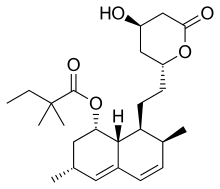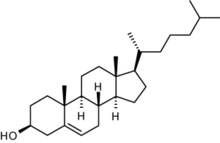Structural Biochemistry/Statin
< Structural BiochemistryStatin

Overview
Statins, also known as HMG-CoA (or "3-hydroxy-3-methyl-glutaryl-CoA reductase or HMGCR") reductase inhibitors, are a class of drugs that lower the level of cholesterol in the blood by reducing the production of cholesterol by the liver. Statins, because they are inhibitors, block the enzyme, HMG-CoA reductase, which is responsible for production of cholesterol. Because high cholesterol has been linked with risk of heart disease, those with increased cholesterol levels may find statins useful as prevention. The top-selling statin is atorvastatin, with the trademark name of Lipitor. Lipitor, which has been manufactured by Pfizer, has been useful in the stabilization of plaques and and in preventing strokes.
History
In 1971, Akira Endo, got into research to search for inhibitors of HMG-CoA reductases to lower the cholesterol levels in liver. He and his team argued that there are microorganisms that may produce this inhibitor of the enzymes to defend themselves against other organisms. First isolated agent was the mevastatin, which was a molecule created from a fungus “Penicillium citrinum” By 1976, another statin was isolated known as the lovastatin from a fungus “Aspergillus terreus”. Then, after few years, other isolated statins begin to hit the market, including Pfizer’s Lipitor in 1985.
Then a link between cholesterol and cardiovascular disease called lipid hypothesis had been suggested. Cholesterol is a waxy substance produced by the liver and found in certain foods, is needed to make vitamin D and some hormones, create bile salts that assist people to digest fat and build cell walls. However, having too much cholesterol is not good since this can lead to heart attacks. During the Coronary Primary Prevention Trail of 1984, Daniel Steinberg, cholesterol researcher conveys that low-fat diet and poorly tolerated medicines such as cholestyramine, clofibrate, and nicotinic acid are all kinds of dietary measures for treatment. Basically to Steinberg, anything that will lower cholesterol can greatly reduce the risk of serious problems such as heart attacks and angina. However, many physicians including that of cardiologists remained unconvinced after what Steinberg have demonstrated.
To advertised statins effectively, Merck had to convince the public and doctors about the dangers of having high cholesterol and illustrated how statins were safe to take and would extend lives. Soon, people became familiar with their cholesterol numbers and understand the difference between what is good and what is bad cholesterol. With this happening, rival pharmaceutical companies started producing their own statins, such as pravastin (Pravaochol) that was manufactured by Sankyo and Bristol-Myers Squibb. In the year 1994, the results of a Merck-sponsored study, the Scandinavian Simvastatin Survival Study or also known as "4S", were announced. Later Merck as Zocor sold simvastatin and this was used on 4,444 patients with heart disease and high cholesterol. In just five years, the study concluded that many patients saw a 35 percent reduction in their cholesterol and the chance of them dying from a heart attack were reduced by 42 percent. This significantly shows that statin is a great type of cure in the end and not anything dangerous. Then in the year 1955, Zocor and Mevacor both made Merck over one billion in US dollars. In 2006, Endo was awarded the Japan Prize and the Lasker-DeBakey Clinical Medical Research Award in the year 2008.
Who Should Take It?
Statins are used for preventing and treating atherosclerosis, which causes chest pains, heart attacks, strokes, and even death in some individuals. So, people with abnormally elevated cholesterol levels, or history of heart attacks should consider taking statins, only if other methods are not working to reduce cholesterols. Exercise and diet are common ways to reduce cholesterol.
Examples of Statin
- Atovastatin (Lipitor, Torvast)
- Fluvastatin (Lescol, Lescol XL)
- Pravastatin (Pravachol, Selektine, Lipostat)
- Rosuvastatin (Crestor)
- Simvastatin (Zocor, Lipex)
- Pitavastatin (Livalo, Pitava)
- Cerivastatin (Lipobay, Baycol)
- Lovastatin (Mevacor, Altocor, Altoprev)
- Mevastatin (Compactin)
- Simvastatin+Ezetimide (Vytorin)
- Lovastatin+Niacin (Advicor)
- Simvastatin+Niacin (Simcor)
- Atorvastatin+Amlodipine (Caduet)
Mechanism
All types of statins basically act the same, there is cascade of actions, that eventually produces cholesterol. HMG-CoA reductases catalyzes the conversion of HMG-CoA to mevalonate during the cholesterol synthesis. By completely inhibit the reductase, it reduces the cholestrol levels. The difference between different statins are their abilities to reduce cholesterol. For now, atorvastatin, or Lipitor, and rosuvastatin (Crestor) are most potent, while fluvastatin (Lescol) is least potent. These are due to the fact that enzymes in the liver that eliminate the Liptor and Crestor are not blocked by many of the drugs that block the enzymes that eliminate other statins, like Lescol. By doing so, it prevents the levels of the drugs from rising and lead to increased toxicity.

Side Effects
Common side effects include: Headache, nausea, vomiting, constipation, rash, diarrhea, rash, weakness and muscle pain Also, serious but rare side effects are liver failure and rhabdomyolysis which is a damage to muscle that can lead to death. Therefore, one should check drug interaction to limit these side effects. There are many controversies if statins are actually useful in lowering cholesterol, and there are some reports that it may even worsen health. For example, a recent report out of University of Glasgow has revealed that cholesterol drugs like Crestor and Lipitor are responsible for increasing risk of diabetes by 9%.
References
- http://upload.wikimedia.org/wikipedia/commons/9/99/Simvastatin.png
- http://www.news-medical.net/health/Statin-History.aspx
- http://www.medicinenet.com/statins/article.htm
- http://en.wikipedia.org/wiki/Statin
- http://upload.wikimedia.org/wikipedia/commons/2/25/Cholesterol.png
- http://kidshealth.org/teen/food_fitness/nutrition/cholesterol.html